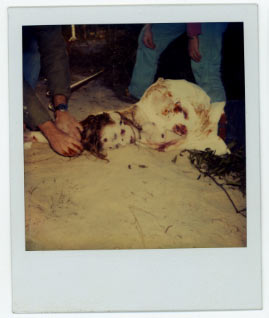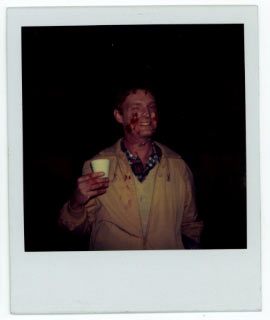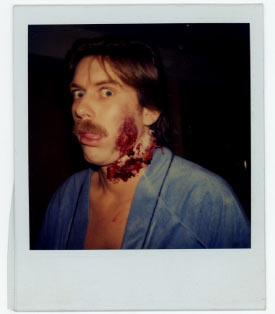[JA Kerswell
talks to Robert Short, the man behind the gory mayhem of THE SLAYER (1982)]
Robert Short is one of those horror fans made good; landing a job that the rest of us can only dream of - and securing an Acadmey Award for his excellence. Over three decades of making fantasy and horror magic come to life on the screen. He has worked on such much loved genre films as HALLOWEEN (1978), PIRANHA, CHOPPING MALL, GALAXY OF TERROR and much, much more. It's a priviledge and a delight to to speak to him. Thank you for taking the time to speak to us Robert and for providing these fascinating behind-the-scenes Polaroids below ...
Q: When I looked at your resume I was seriously impressed by it! You've worked on some of the best loved cult films and blockbusters of the past 30 years (including getting an Academy Award for BEETLEJUICE (1988)). However, today we're going to be chatting about some of the films that, perhaps, you don't get to speak about so often. Firstly, can you tell us how you got involved in the business?
 I always loved horror and monster films. My Dad took me to see "It came from Beneath the Sea" in a theatre when I was around 6 and I been hooked ever since. I originally wanted to be a stuntman but after training to become one I discovered the competition was to fierce for me. I guess I valued my neck a little more than the other guys. Looking for a way into the business I got a job at Don Post Studios, which makes Halloween monster mask and had an FX lab that did small movie jobs. After learning the ropes I became a lab manager/Designer/Sculptor and eventually got the opportunity to leave Post and head up an FX department on the Roger Corman film "Piranha". From there I just tried my best to keep on going. I always loved horror and monster films. My Dad took me to see "It came from Beneath the Sea" in a theatre when I was around 6 and I been hooked ever since. I originally wanted to be a stuntman but after training to become one I discovered the competition was to fierce for me. I guess I valued my neck a little more than the other guys. Looking for a way into the business I got a job at Don Post Studios, which makes Halloween monster mask and had an FX lab that did small movie jobs. After learning the ropes I became a lab manager/Designer/Sculptor and eventually got the opportunity to leave Post and head up an FX department on the Roger Corman film "Piranha". From there I just tried my best to keep on going.
Q: I noticed that one of your first credits was for HALLOWEEN in 1978. Can you tell us a little bit about that?
While at Don Post Studios the producers of HALLOWEEN approached the Don Post Lab about creating a blank white mask for the film. Bill Malone, Rob Tharp and myself scrounged around the shop and came up with a defective William Shatner mask that could be used. Rob, I believe painted it white, Bill cut off the Star Trek side burns, enlarged the eyes and painted the brown hair black. At the time we had no idea that it would become the icon that it became.
Q: How did you get involved with THE SLAYER? I see Variety says that the film was set to began production in 1980. Does that fit your recollections?
I don't even recall how I got the invitation to come in and bid on the show. I believe it was through a recommendation of a friend. They had a small office in the North Hollywood area.
Q: Roger Corman said that the effects for THE SLAYER were, “... some of the best gore effects ever done for a film.” High praise indeed! Did you work on both the monster design and the murder scenes?
 I was always pleased with Roger's quotes about my work in the film. I was very keen on doing a good job and really gory effects for films was just coming into vogue so I wanted to push them as far as I could, I'd designed the main creature as something that might spring from a local legend from deep in the south. Very decayed, tattered and almost Zombie-like. The main feature I wanted was long fingernails and long pointed teeth for the Slayer. Yes, I also did the gore effects as well such as the pitchfork scene and the severed head in the bed. The head was done with a false bottom bed with the actor using a neck appliance to simulate the stump. I was always pleased with Roger's quotes about my work in the film. I was very keen on doing a good job and really gory effects for films was just coming into vogue so I wanted to push them as far as I could, I'd designed the main creature as something that might spring from a local legend from deep in the south. Very decayed, tattered and almost Zombie-like. The main feature I wanted was long fingernails and long pointed teeth for the Slayer. Yes, I also did the gore effects as well such as the pitchfork scene and the severed head in the bed. The head was done with a false bottom bed with the actor using a neck appliance to simulate the stump.
Q: If you did work on the scene where one character gets a pitchfork through her back (with the prongs appearing through the front) do you recall how that effect was achieved?
Knowing the camera only sees in flat 2D I knew that I could make a very deep replica of the actress's chest as long as it was the same width as her real body. That way a "spikes on rails" system could be built and attached to the front of the actress and not be seen by the camera. What makes that scene really work is the rain and camerawork the created a real immersive feeling to the shot.
Q: Carl Kraines told us the lengths he had to go through as an actor (playing The Slayer). He said if an uncomfortable, but incredible, beginning to his acting career! He remembers you operating the animatronics. What do you recall about the production and working with the cast and crew?
The Slayer itself was a very uncomfortable mechanical head made of ridged urethane foam skinned with a foam latex skin. Carl couldn't see out of the head because of the eye mechanizims so he was a real trouper about getting the character to work just right.
Q: Were you aware that the film won a certainly notoriety in the UK as one of the fabled 'video nasties' in the early-mid 1980s?
 No, but it sounds pretty cool. No, but it sounds pretty cool.
Q: Talking of censorship, when I spoke to Steve LaPorte about his work on SUPSERSTITION (1982) he expressed disappointment that in the finished film much of the intricacies of the creature (witch) design were lost. Is that the bane of a special effects person's life, loosing things to the cutting room floor?
I have to admit I have been very lucky and that almost every thing I have built has not hit the cutting room floor. There have been a couple of times where we have built something and the scene was never shot because of a change in the script but that's different than hitting the cutting room floor, On the other hand I just finished supervising the Visual Effects for a Fox pilot called "Exit Strategy" and the network may never air it. In that case the entire show may hit the cutting room floor. So I guess that may make up for all the others.
Q: You also worked on another film that tentatively touched on the slasher movie themes, 1986's CHOPPING MALL. What was your involvement with that project?
For "Kilbots" or Chopping Mall as it was called, I designed and built the robots for it. My good friend Jim Wynorsky asked me to come up with robots that were reminiscent of the ones in the film called GOG. The real challenge with those was creating something that was fully remote controlled.
Q: You've remained successful in the business for the past three decades. Has the switch from latex, animatronics and practical effects to CGI been a challenge? And can you see a time when all practical effects will be a thing of the past?
Even actor's will eventually be a thing of the past but I don't think we are going to have to worry about them or practical effects disappearing for a while. I really believe that the trick is to use the right tool for the right job and not succumb to the point of view of "if you use a hammer then everything looks like a nail".
Q: Finally, a huge thank you for taking time to chat about just a small section of your current work. Can you tell us a little bit about what you're up to now?
In the last six months I have been to India to shoot all the stock footage for a TV show called "Outsourced", Supervised visual effects and traveled to Shanghai for the Fox pilot "Exit Strategy" starring Ethan Hawk and just returned from Texas where I was working with friends on an ultra gory micro-budget feature called "Knucklebones". Ironically it is a homage to 80's horror film's like the Slayer and features a group of teens as they fight for their live against a demon. It's bloody, visceral and totally old school. I designed the creature and created the gore effects through GOTCHA! my Halloween product company I own with business partner Dirk Hagen.
Thanks for asking about The Slayer because I still have very fond memories of it and am proud that it was one of the early pioneers in the genre.
Read the  review of THE SLAYER.
review of THE SLAYER.
Visit Robert's website.
Listen to the Hysteria Continues podcast dedicated to THE SLAYER, with an audio interview with the Slayer himself, Carl Kraines! |

